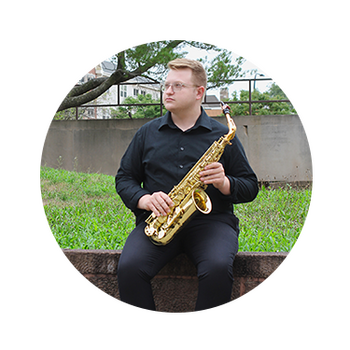How to Play Your First Altissimo Note: Part Four
by Jack Thorpe
Date Posted: July 09, 2024

What are some more altissimo exercises to practice extending my range?
Front Key Exercises
The “front keys” on the saxophone are the alternate E, F, and F♯ fingerings that can be played using the front F or “X” key (the teardrop-shaped key or extra pearl above the pearl you play with your index finger on your left hand). These front key notes are a great way to practice moving between the normal range of the saxophone and the altissimo range. Eugene Rousseau’s book Saxophone High Tones does a great job explaining the bridge between these two registers and provides great front key exercises that I highly recommend to any student beginning their altissimo journey. See front fingerings below.
Soprano and Alto Front Fingerings

The front keys fingerings for tenor saxophones are slightly different than those for soprano and alto. On the baritone saxophone, the front fingerings are only available for E, F, and F♯. Baritone saxophone fingerings for G and G♯ work best on saxophones with a high F♯ key. See these slightly different fingerings below.
Tenor Front Fingerings

Baritone Front Fingerings

To play the front keys, you will notice that your airstream has to be slightly slower than normal, which is similar to the Crunch G and altissimo register. In order to play the front keys successfully, you may also notice that the tip of your tongue might need to be slightly lower similar to the position used to manipulate the mouthpiece A into an A♭.
These front key notes are also very fragile, and while it can be frustrating to learn them because of their initial instability, learning the proper oral cavity and tongue position for these notes is invaluable when further expanding your altissimo range. Once the front E, F, and F♯ are comfortable, practice the front G and G♯. Once you can produce all of these front key notes, use the front key exercises in Rousseau’s book to continue improving your front key and altissimo note production.
Altissimo Scales
Once you feel comfortable with your first couple of altissimo notes, you should start practicing altissimo scales with a sounding drone on tonic. Practicing altissimo scales helps you learn how to approach these altissimo notes by stepwise motion.

Once a scale feels comfortable, practice playing your major arpeggio into the altissimo range.

There are many altissimo fingering charts you can find online as well as in books like Debra Richtmeyer’s The Richtmeyer Method for Saxophone Mastery, Eugene Rousseau’s Saxophone High Tones, Jean-Marie Londeix’s Hello! Mr. Sax, Donald Sinta’s Voicing – An Approach to the Saxophone’s Third Register, and Marcus Weiss and Bruno Netti’s The Techniques of Saxophone Playing. Be sure that no matter what altissimo note you are trying to play that you are always paying attention to:
- Quality of Sound
- Intonation
- Airstream Speed
- Using the Correct Embouchure
If you ever get frustrated with learning altissimo, remember to go back to basics with mouthpiece pitch exercises and playing long tones in all registers of the instrument. Learning altissimo won’t happen overnight, but consistent proper practice will yield positive results over time!
More from this Series

About Jack Thorpe
Atlanta based saxophonist Jack Thorpe currently serves as an Artist Affiliate of saxophone at Georgia State University and the adjunct instructor of saxophone at the University of Tennessee at Chattanooga. As a concerto soloist, he has performed with the Georgia State University Symphonic Wind Ensemble, the Stephen F. Austin State University Symphonic Orchestra, and the University of Illinois Symphony Orchestra. Through his work as the alto player in the Versa Quartet, Thorpe won first place in the 2020 North American Saxophone Alliance’s Quartet Competition and performed William Bolcom's Concerto Grosso for saxophone quartet and wind band with the University of Illinois Wind Symphony. In 2017, he co-founded the Snow Pond Saxophone Quartet, a chamber ensemble formed to represent the Frederick L. Hemke Saxophone Institute at the Snow Pond Center for the Arts to international audiences. The quartet performed throughout Japan in 2017 alongside soloist Masato Kumoi and toured the southeastern United States in 2019.
In March of 2022, he was named the winner of the University of Illinois's Presser Graduate Award. With funding from this award, he is currently commissioning six composers who belong to traditionally under-represented communities in classical music to write solo and electroacoustic works for saxophone. Thorpe’s interests in collaborating with composers to create new works has also influenced his work as a chamber musician. Recently, Thorpe's saxophone duo, Vex, has premiered new works by Emily Koh, Yaz Lancaster, and Anthony R. Green.
Thorpe holds a D.M.A in saxophone performance and literature form the University of Illinois, an M.M. in saxophone performance from Stephen F. Austin State University, and a B.M. in saxophone performance from Georgia State University where he was the recipient of the Presser Undergraduate Scholar Award. His teachers include Debra Richtmeyer, Jan Berry Baker, and Nathan Nabb with additional study under Frederick L. Hemke.